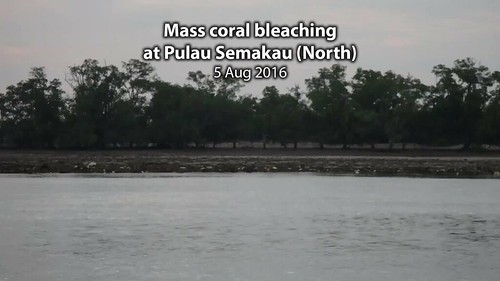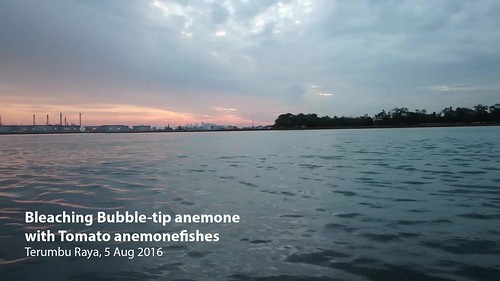Mass coral bleaching is happening at Terumbu Raya.
I surveyed the reefier edge opposite Pulau Semakau (North). I estimate about 30% of the hard corals are bleaching. I saw a few small leathery soft corals and none of them were bleaching. I estimate 10-15% of the corals have died recently. On a positive note, I saw a sea turtle!
This submerged reef lies opposite Pulau Hantu and the petrochemical plants on Pulau Bukom, and is next to Pulau Semakau.
Here's a clip of mass coral bleaching on Terumbu Raya. Mass coral bleaching is also happening on Pulau Semakau (North) just across the channel.
Shouldn't mass coral bleaching in Singapore be ending? From the NOAA's coral reef watch satellite monitoring, Singapore is in the blue Watch zone. But our corals are still bleaching.
What is coral bleaching?
Coral are colonies of tiny animals called polyps. Each polyp lives inside a little hard skeleton. The huge colony is made up of the skeletons of countless polyps. The polyps of all reef-building hard corals harbour microscopic, single-celled algae (called zooxanthellae). The polyp provides the zooxanthellae with shelter and minerals. The zooxanthellae carry out photosynthesis inside the polyp and share the food produced with the polyp. Corals generally have white colour skeletons, which is believed to assist in photosynthesis by reflecting light onto the zooxanthellae.
Coral are colonies of tiny animals called polyps. Each polyp lives inside a little hard skeleton. The huge colony is made up of the skeletons of countless polyps. The polyps of all reef-building hard corals harbour microscopic, single-celled algae (called zooxanthellae). The polyp provides the zooxanthellae with shelter and minerals. The zooxanthellae carry out photosynthesis inside the polyp and share the food produced with the polyp. Corals generally have white colour skeletons, which is believed to assist in photosynthesis by reflecting light onto the zooxanthellae. When there is massive loss of zooxanthellae in a hard coral colony, the polyps become colourless and the underlying white skeleton shows through. Thus patches of the colony appear pale, white or 'bleached'. The polyps are still alive and the hard coral is not dead (yet).
Hard corals harbouring zooxanthellae live close to the upper limit of temperature tolerance. Thus a temperature increase of even 1-2 degrees centigrade can redust in bleaching. It is believed that global warming will lead to massive bleaching. Once the cause of bleaching is removed, however, polyps may eventually regain zooxanthellae (which live freely in the water) and thus recover their health. But prolonged bleaching can kill corals and seriously damage large sections of a reef.
Factors believed to cause bleaching include: temperature fluctuations (too high or too low), excessive exposure to ultraviolet light, excessive sedimentation in the water, changes in salinity and disease. It is generally believed that bleaching is related to unusual prolonged temperature increases in the seawater.
We last surveyed this shore a few months ago in Mar 2016, when some signs of bleaching were seen, but not mass coral bleaching. Today, I did see some corals that were not bleaching. But I get the sense that there were fewer living hard corals compared to our survey in Jun 2015.
Surprisingly, a few small colonies of Acropora corals, most not bleaching, although some had patches that recently died.
I saw two small Cauliflower corals that were bleaching with patches that recently died. I saw one small colony of Crinkled sandpaper coral that was a healthy brown without any dead patches. Most of the Disk corals I saw were also alright.
I saw a few Galaxy corals and most were alright except for one large colony.
About half of the Anemone corals were bleaching.
I saw some small Carnation corals and most of them were bleaching. I saw one large Lettuce coral and while half of it was dead, the remaining that was alive was not bleaching.
Most of the Brain corals were still bleaching, with only one colony that looks somewhat normal.
And all the Anchor corals I saw were mostly bleaching, with portions that were recently dead.
Many Merulinid corals were still bleaching, some with patches of recently dead tissue that generally make up 10-15% of the colony.
I saw some Sea mat zoanthids that were bleaching and small patches of bleaching Button zoanthids. I saw a few small colonies of leathery soft corals and none of them were bleaching. The most abundant cnidarian on the shore were Fine feathery soft corals and none of them were bleaching.
Sea anemones harbour zooxanthellae and thus can also bleach. I saw several small bleaching Bubble tip sea anemones. They all had Tomato anemonefishes in them. I also saw several Frilly sea anemones and only a few were bleaching. I saw one Haddon's carpet anemone, and a few Giant carpet anemones all of them not bleaching. I didn't see the Fluted giant clams that we saw on our trip in Jun 2015. But I did get a glimpse of a sea turtle when it popped up for a breath, then disappeared underwater again. So no photo...
I did a quick check of the middle part of the reef flats. Most of it was bare of seagrass, instead being covered by a growth of fine black filamentous stuff, possibly cyanobacteria?
There were some patches of seagrasses but they were all heavily covered in epiphytes. These include Spoon seagrass (small leaf blades), Tape seagrass (with cropped leaf blades) and what looks like Sickle seagrass and possibly Serrated ribbon seagrass.
I did not come across any fishing nets or traps. But I did encounter a deep hole (red arrow) next to the reef edge, with a big pile of coral rubble (blue arrow) next to the hole. A sign of a recent boat strike.
While there is not much we can do when our corals start bleaching, we can do a lot to stop other stresses that impact our reefs so the corals are in better health and don't succumb after bleaching.
High res photos of mass coral bleaching in Singapore for free download on wildsingapore flickr
Others on this trip: Nicholas Yap.






















